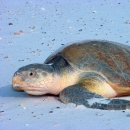Featured Species
The mild winters, bay waters and abundant food supply attract more than 400 species of birds to Aransas National Wildlife Refuge, including the whooping crane, one of North America’s rarest birds.
Situated primarily on the Blackjack peninsula, the main unit of the Aransas Refuge lies behind the protective influence of Matagorda Island, part of a long chain of barrier islands extending down the Texas coastline. The refuge is surrounded by several shallow bays where strong winds push bay waters onto a landscape that, on the mainland, gradually shifts from salt to brackish and eventually freshwater marsh. It is this range of habitat that supports a diversity of wildlife.
Between land and water, the saltmarsh habitat is made up of vegetation that thrives in the saline environment. The salt-tolerant plants not only diminish the impacts of waves, currents and tides, they filter pollutants and provide habitat for hermit crab and juvenile flounder. Moving inland, the fresh and saltwater begin to mix. These brackish waters are nurseries for young fish and are teeming with blue crab and shellfish, food sources for whooping cranes, herons and other wildlife. Gradually, the influence of salt water is completely diminished and the freshwater marshes emerge. These freshwater systems support a very different plant community and are critical to many species living in the coastal environment. They are havens for alligators, turtles, frogs, snakes and many other wildlife species that depend on freshwater for their survival.
Beyond the refuge’s marshland habitat are open oak savannahs and low sandy prairie openings, as well as a mosaic of oak woodlands. The diverse plants found within coastal prairie are important habitat for pollinators like bees and butterflies. The prairie also offers excellent opportunities to enjoy Texas’ colorful wildflowers or watch raptors gliding overhead in search of prey. In the spring, white-tailed deer can be seen grazing on the prairie’s tender grasses. At other times, the deer move into the refuge’s woodland areas where they feed on acorns. These coastal woodlots provide important habitat for many species of wildlife, including neotropical birds migrating between North and Central America. The refuge’s oak mottes provide a resting place where many species of birds can stop and refuel during their long and often perilous journey.
Directly across the bay from the Blackjack peninsula is the Matagorda Island Unit, part of the Aransas National Wildlife Refuge. The Island serves as a barrier to the winds and ocean waves generated in the Gulf of America and it absorbs the energy of hurricanes and winter storms. The beach and dune system are not only important buffers, they provide nesting grounds for Kemp’s Ridley sea turtles and foraging habitat for piping plovers. On the backside of the dune system are shallow freshwater lagoons, habitat utilized by whooping cranes as well as coyotes, reddish egrets and many other species. This unique barrier island ecosystem supports one of eight major estuaries along the Texas coast and is host or home to a diversity of wildlife species that have evolved with, and grown to depend upon, the ever-changing ecosystem.





